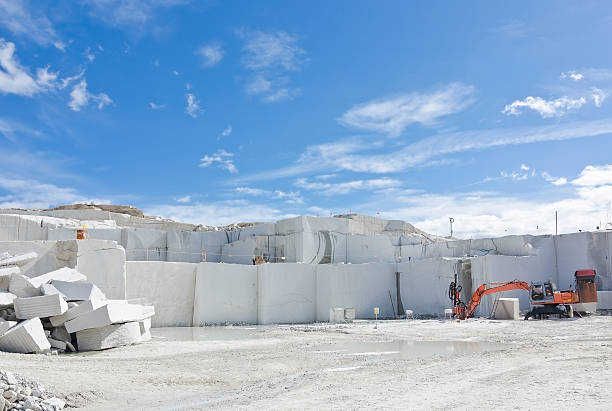Diving right into of Granite Quarries in South Africa
Diving right into of Granite Quarries in South Africa
Blog Article
Discovering the Rich History and Sustainable Practices of Granite Quarrying
As we stand on the precipice of discovering the elaborate tapestry of granite quarrying, a trip via time exposes not just the physical act of removing stone but additionally the cultural and historic value woven into the really textile of this practice. From the old beginnings that laid the foundation for modern quarrying methods to the lasting practices that are forming the future of this market, each carve mark on granite surfaces narrates waiting to be uncovered (granite quarries in south africa). The legacy of granite quarrying stretches much beyond plain extraction; it is a testimony to human ingenuity, strength, and the enduring appeal of this marvelous stone
Ancient Beginnings of Granite Quarrying
Dating back to ancient civilizations, the method of quarrying granite has actually been an essential component of human history and architectural innovation. The earliest evidence of granite quarrying go back to old Egypt, where massive pyramids and complex sculptures were crafted from this durable stone. The Egyptians made use of primitive tools to draw out granite blocks from quarries, showcasing the relevance of this material in their significant building and constructions.
Progressing in background, the Greeks also made considerable payments to the quarrying of granite. The Greeks used granite in different building wonders, such as temples and sculptures, showing their ability in shaping and carving this sturdy stone. The Romans better refined the techniques of quarrying granite, utilizing innovative tools like knives and hammers to essence and form granite for their legendary frameworks.
Via the centuries, the practice of quarrying granite has developed, with contemporary innovations boosting performance while keeping the timeless appeal of this all-natural stone - granite quarries in south africa. From old human beings to modern contractors, the legacy of granite quarrying remains to shape our world
Advancement of Quarrying Techniques
The evolution of quarrying techniques has been noted by a continuous development in the direction of higher efficiency and precision in extracting granite. From the basic methods used by our ancestors to the sophisticated technologies made use of in modern-day quarrying procedures, the sector has actually undergone considerable developments. Early quarrying techniques entailed manual work with basic tools such as knives, hammers, and wedges to draw out granite blocks from the earth. As worlds proceeded, strategies like fire-setting and primitive explosives were introduced to promote the extraction process.
In even more current times, the development of equipment reinvented the quarrying sector, making it possible for much faster removal prices and increased performance. Technologies such as ruby cable saws, high-pressure water jets, and pneumatically-driven drills have come to be conventional in modern quarries, permitting exact cutting and reduced waste. Improvements in computer-controlled equipment and 3D modeling have actually enhanced quarrying operations, leading to minimal ecological influence and enhanced sustainability practices. As the need for granite remains resource to rise, the evolution of quarrying strategies stays integral to conference sector requires efficiently and sustainably.
Cultural Importance of Granite
Granite holds an extensive social value throughout numerous human beings as a result of its long-lasting presence in building work of arts and prized monoliths. From the magnificent pyramids of Egypt to the elaborate carvings of the Angkor Wat temple in Cambodia, granite has been a material of option for revealing magnificence and long life in social heritage. In old Rome, granite columns decorated holy places and public structures, representing stamina and permanence. The cultural importance of granite prolongs beyond its physical characteristics; it embodies resilience, stability, and timelessness, making it a symbol of sustaining heritages and practices.

Lasting Practices in Quarrying
Amidst the abundant background of granite quarrying and its cultural importance lies a growing focus on lasting methods within the market. As environmental awareness and concerns concerning source exhaustion have heightened worldwide, the quarrying industry has increasingly welcomed lasting techniques to reduce its effect on the atmosphere and surrounding neighborhoods.

Additionally, recovery and rehab of quarry websites post-extraction are indispensable to lasting practices. By restoring quarried areas to an all-natural or valuable state, such as creating wildlife environments or recreational spaces, quarriers can offset the environmental footprint of their operations and contribute positively to the regional environment.
Legacy of Granite Quarrying
With a historic background soaked in blog here workmanship and commercial progression, what sustaining influence has granite quarrying left on the landscape of modern-day culture? The heritage of granite quarrying goes beyond simple extraction methods; it has shaped architectural wonders, city landscapes, and social heritage worldwide. The sturdy nature of Click Here granite has actually made it a preferred selection for monoliths, buildings, and facilities, standing as a testament to the skill and artistry of quarry workers throughout generations.
In addition, the financial footprint of granite quarrying can not be ignored. The sector continues to supply employment possibility and drive local economic climates in areas where granite removal is common. It has also stimulated technological developments in quarrying strategies and tools, causing much more efficient and lasting methods.
In terms of sustainability, the tradition of granite quarrying consists of efforts to minimize environmental effects via improvement projects and accountable resource administration. By balancing economic interests with ecological stewardship, the industry aims to ensure that future generations can proceed to benefit from this long-lasting natural source.
Final Thought

Report this page